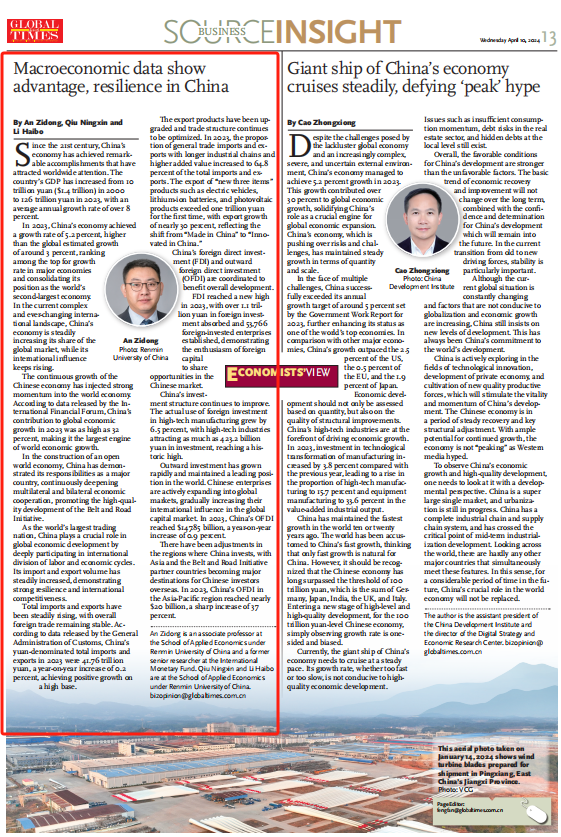


A view of the skyline of Beijing's CBD area. Photo: VCG
Since the 21st century, China's economy has achieved remarkable accomplishments that have attracted worldwide attention. The country's GDP has increased from 10 trillion yuan ($1.4 trillion) in 2000 to 126 trillion yuan in 2023, with an average annual growth rate of over 8 percent.
In 2023, China's economy achieved a growth rate of 5.2 percent, higher than the global estimated growth rate of around 3 percent, ranking among the top in the world's major economies and consolidating its position as the world's second-largest economy. In the current complex and ever-changing international landscape, China's economy is steadily increasing its share of the global market, while its international influence keeps rising.
The continuous growth of the Chinese economy has injected strong momentum into the world economy. According to data released by the International Financial Forum, China's contribution to global economic growth in 2023 was as high as 32 percent, making it the largest engine of world economic growth.
In the construction of an open world economy, China has demonstrated its responsibilities as a major country, continuously deepening multilateral and bilateral economic cooperation, promoting the high-quality development of the Belt and Road Initiative.
Stable price levels ensure the smooth operation of China's macroeconomy. Against the backdrop of insufficient momentum in global economic recovery and high global inflation levels, China's overall price level has remained relatively stable.
China's 2023 consumer price index (CPI), the main gauge of inflation, increased 0.2 percent on a yearly basis. This moderate increase is far lower than the 4.1 percent inflation rate in the US and the 5.4 percent in the Eurozone, forming a stark contrast with major developed economies struggling with high inflation.
One of the main driving factors for the widening gap in GDP between China and the US in 2023 is the significant difference in the inflation rates of the two countries. China's inflation rose by 0.2 percent for the whole year, while the US saw a 4.1 percent increase in inflation. This directly led to a large disparity in the nominal GDP growth of the two countries. Additionally, the weaker Chinese yuan is another factor contributing to this gap, with the exchange rate of the yuan increasing from 6.7 percent to 7.1 percent compared to the previous year.
However, in purchasing power parity (PPP) terms, China's GDP in 2023 stood at 32.9 trillion international dollars, while the US' GDP in 2023 stood at 26.95 trillion international dollars, according to IMF data. After removing the effects of price levels and exchange rates, the Chinese economy continues to show a steady upward trend.
In 2023, China's overall consumption maintained stable growth, with total retail sales of consumer goods exceeding 47 trillion yuan. Final consumption expenditure drove GDP growth by 4.3 percentage points. The contribution rate of final consumer spending to economic growth reached 82.5 percent.
In 2023, China's total fixed asset investment reached 50.3 trillion yuan, a year-on-year increase of 3 percent. Among them, investment in high-tech industries grew by 10.3 percent, while infrastructure investment increased by 5.9 percent and manufacturing investment increased by 6.5 percent.
As the world's largest trading nation, China plays a crucial role in global economic development by deeply participating in international division of labor and economic cycles. Its import and export volume has steadily increased, demonstrating strong resilience and international competitiveness.
Total imports and exports have been steadily rising, with overall foreign trade remaining stable. According to data released by the General Administration of Customs, China's yuan-denominated total imports and exports in 2023 were 41.76 trillion yuan, a year-on-year increase of 0.2 percent, achieving positive growth on a high base.
The export products have been upgraded and trade structure continues to be optimized. In 2023, the proportion of general trade imports and exports with longer industrial chains and higher added value increased to 64.8 percent of the total imports and exports. The export of 'new three items' products such as electric vehicles, lithium-ion batteries, and photovoltaic products exceeded one trillion yuan for the first time, with export growth of nearly 30 percent, reflecting the shift from 'Made in China' to 'Innovated in China.'
China's foreign direct investment (FDI) and outward foreign direct investment (OFDI) are coordinated to benefit overall development.
FDI reached a new high in 2023, with over 1.1 trillion yuan in foreign investment absorbed and 53,766 foreign-invested enterprises established, demonstrating the enthusiasm of foreign capital to share opportunities in the Chinese market.
China's investment structure continues to improve. The actual use of foreign investment in high-tech manufacturing grew by 6.5 percent, with high-tech industries attracting as much as 423.2 billion yuan in investment, reaching a historic high.
Outward investment has grown rapidly and maintained a leading position in the world. Chinese enterprises are actively expanding into global markets, gradually increasing their international influence in the global capital market. In 2023, China's OFDI reached $147.85 billion, a year-on-year increase of 0.9 percent.
There have been adjustments in the regions where China invests, with Asia and the Belt and Road Initiative partner countries becoming major destinations for Chinese investors overseas. In 2023, China's OFDI in the Asia-Pacific region reached nearly $20 billion, a sharp increase of 37 percent.
作者:安子栋 邱宁昕 李海博
单位:中国人民大学应用经济学院
来源:环球时报
设计 责编:刘丹青 马文林
审核:安子栋 浩爽
相关新闻
-

应用经济学院师生赴通州大运河开展实践研学
2025/12/11
-

中国人民大学应用经济学院和西藏大学经济与管理学院开展联学共建暨党建经验交流活动
2025/12/11
-

学习贯彻党的二十届四中全会精神,应用经济学院教授开讲!
2025/12/10
-

强国一代有我在!应用经济学院学子唱响《先锋·人大组歌》
2025/12/10



